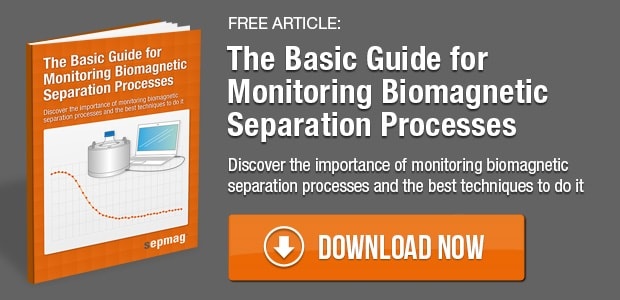In June of 2014, a group in Dublin, Ireland created a novel assay to detect Herpes Simplex Virus-1 (HSV-1) using magnetic separation and flow cytometry. Previous methods of detection relied on cell culture, polymerase chain reaction, enzyme immunoassay, or fluorescent antibody diagnostics. Those methods, while quite effective, are time consuming and require a full laboratory. Magnetic separation takes seconds, and the emergence of portable flow cytometry systems makes this new assay feasible for use in the field.
Multiple-antigenic-peptides (MAPs) allow multiple binding events as the free energy is reduced after each successive bond forms. This is an important feature to this method because it allows for the aggregation of virus and beads, which is the core of the assay. First, the iron oxide beads are surface functionalized with HSV-1-specific MAPs. These beads are added at a concentration of 2 x 106 beads per mL of serum containing HSV-1 and incubated for 30 minutes. The virus-bound beads are further aggregated by the application of an external magnet. This magnetic separation process allows for the unwanted serum and contaminants to be washed away while the virus-bound beads are collected for flow cytometry. Fluorescent markers are not required in this sort because the assay only requires information about cell size, which is gathered by measuring forward and side scatter on unlabeled cells or beads. The unbound singular beads are identified as a distinct population from the bead-virus aggregates. Therefore, if the virus exists in serum the HSV-1-specific MAP functionalized beads will bind to the virus with multiple binding events, and clumps of beads and virus are identified as large aggregates by flow cytometry. If there is no virus present then no clumps form and only single beads are detectable.
The assay was evaluated at concentrations of HSV-1 in serum ranging from 2 virus particles per mL to 200 million virus particles per mL. The percentage of aggregates increased as the number of virus particles in the serum increased. The aggregate percentage reached a maximum at 2 million virus particles per mL. As the concentration increased beyond that point the percentage of aggregates decreased because all of the peptides were saturated with virus, and the remaining particles were counted as single cells. There was some background aggregation due to the presence of streptavidin on the beads. To decrease this aggregation without virus particles, the authors coated the paramagnetic beads with polyethylene glycol (PEG) and removed the streptavadin. These changes decreased the nonspecific binding and reduced the background aggregation of the beads.
The authors have begun to characterize and fine-tune this assay by eliminating background aggregation and mapping the virus-bead aggregation percentage at varying virus concentrations. Their work suggests that this novel method of detecting Herpes Simplex Virus-1 hold promise. However, extensive characterization and testing with real samples needs to be completed before it can be used reliably in patient settings.
Full Article:
Rapid, highly sensitive detection of herpes simplex virus-1 using multiple antigenic peptide-coated superparamagnetic beads.Ran, Ying-Fen and Fields, Conor and Muzard, Julien and Liauchuk, Viktoryia and Carr, Michael and Hall, William and Lee, Gil U. Analyst, 2014. 139, 6126-6134.
Related news:




